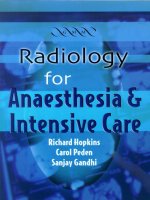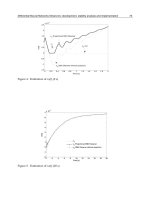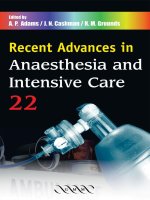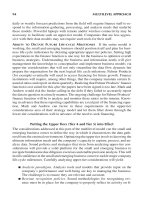Radiology for Anaesthesia and Intensive Care - Part 5 docx
Bạn đang xem bản rút gọn của tài liệu. Xem và tải ngay bản đầy đủ của tài liệu tại đây (962.77 KB, 36 trang )
This page intentionally left blank
3
Trauma radiology
Chest trauma: case illustrations 126
Blunt abdominal and pelvic trauma: case illustrations 137
125
Chap-03.qxd 09/Oct/02 11:04 AM Page 125
Chest trauma: case illustrations
Question 1
47-year-old male.
High speed road traffic accident.
Chest pain, breathless.
You are asked to assist in the emergency unit with a view to admission to
intensive care. A chest drain has already been placed.
Widened mediastinum on the chest X-ray.
A CT scan of the chest (Figs 3.1 and 3.2) was performed.
What are the injuries?
Trauma radiology
3
126
Fig. 3.1 Quiz case.
Fig. 3.2 Quiz case.
Chap-03.qxd 09/Oct/02 11:04 AM Page 126
Answer
Traumatic aortic injury
Traumatic aortic injury is a major cause of mortality in patients with
blunt thoracic trauma. The commonest cause is motor vehicle accidents,
but also includes falls and blast injuries, the common mechanism being
deceleration. About 80–90% of patients who sustain this injury die prior to
hospital admission. Most patients who reach hospital alive have a tear at
the aortic isthmus just distal to the subclavian artery. The injury is caused by
shearing stress between the aortic arch, which is relatively fixed and the
more mobile descending aorta.
Rapid diagnosis and surgical treatment is essential as 40% of patients
will die within 24 hours without treatment.
Clinical signs include upper limb hypertension (due to acute coarctation
effect) and wide pulse pressure. In patients, who survive aortic injury,
Chest trauma: case illustrations
3
127
Fig. 3.3 Angiogram of acute aortic injury. There is a focal bulge immediately distal to
left subclavian artery. This is a typical site for acute aortic injury seen in deceleration
accidents.
Chap-03.qxd 09/Oct/02 11:04 AM Page 127
the integrity of the aorta is often maintained only by the adventitia.
Widening of the mediastinum on chest X-ray is caused by mediastinal
blood. This is not usually due to aortic bleeding as this leads to sudden
death. Mediastinal blood can come from injury to other vessels,
e.g. azygous, paraspinal vessels. The great utility of the chest X-ray is not
in diagnosing acute aortic injury but in excluding it. A normal chest X-ray
has a negative predictive value of 98%. Numerous signs on the chest
X-ray have been described in association with traumatic aortic injury.
These signs are identified secondary to the associated mediastinal
haematoma rather than the aortic injury itself. The signs include rightward
tracheal shift, rightward deviation of any nasogastric tube, right
paratracheal widening and widening of the paraspinal lines. Two of the
most valuable signs are loss of contour of the aortic arch and contour
abnormalities of the superior mediastinum, mediastinal widening, upper
rib fractures, a left apical pleural cap are further recognised signs.
Trauma radiology
3
128
Fig. 3.4 Angiogram of acute aortic injury. This projection has been chosen to best
illustrate the dissection/intimal flap which is seen projecting into the aortic lumen.
This corresponds to the intimal flap seen on the contrast enhanced CT (Fig. 3.2).
Chap-03.qxd 09/Oct/02 11:04 AM Page 128
Further investigation should be undertaken if aortic injury is suspected.
There is debate regarding the place of contrast enhanced CT and
angiography. CT is an excellent way of identifying mediastinal haematoma;
it will visualise contour abnormalities of the aorta. The example above
(Figs 3.1 and 3.2) demonstrates acute aortic injury with mediastinal blood
and an intimal flap within the lumen of the aorta. In addition, there are rib
fractures and pleural effusions.
Angiography has traditionally been regarded as the standard reference
technique for evaluating patients with traumatic aortic injury. The typical
appearance of acute aortic injury is demonstrated in Figs 3.3 and 3.4.
There is abnormal outpouching of the aorta just distal to the origin of the
left subclavian artery. The angiographic appearance is of a contained
pseudoaneurysm. In addition, there is a linear component due to an intimal
flap seen distal to the pseudoaneurysm.
Treatment is with prompt surgical repair. Control of blood pressure is
advised until surgical repair can be accomplished.
Chest trauma: case illustrations
3
129
Chap-03.qxd 09/Oct/02 11:04 AM Page 129
Question 2
A call has come from a paramedic team that a male aged 38 is shortly
arriving in the emergency unit. He has sustained steering wheel injuries to
the chest following a high speed motor vehicle accident.
How are you going to deal with the initial assessment and
management?
What does the CT scan (Fig. 3.5) show?
What are the main injuries sustained in blunt chest trauma?
Trauma radiology
3
130
Fig. 3.5 Quiz case.
Answer
Initial assessment and management should follow Advanced Trauma Life
Support (ATLS) guidelines [1] – A, B, C, D, E. A cervical spine injury
should be assumed in any patient with multi-system trauma.
Airway maintenance (with cervical spine control)
Speak to the patient – do they respond? If the patient is able to
communicate verbally the airway is unlikely to be in immediate danger.
Repeated assessment of airway patency should still be performed.
All patients must receive oxygen (10–15 L/min from a reservoir bag if
breathing spontaneously). If airway obstruction is present simple measures
to clear the airway, chin lift or jaw thrust, should be undertaken
immediately. Reduced conscious level (Glasgow Coma Score of 8 or less)
airway disruption or inability to oxygenate the patient by face mask
indicate the need for a definitive airway. Endotracheal intubation (with
stabilisation of the cervical spine) can be performed with a rapid sequence
Chap-03.qxd 09/Oct/02 11:04 AM Page 130
induction and cricoid pressure, or with awake fibre-optic intubation
depending on the clinical circumstances. When assessing and managing the
airway in patient’s with blunt chest trauma it is important to look for other
injuries to the head, face, cervical spine, and potential sites of injury to
the larynx, trachea or lower airway. Laryngeal or tracheal injury may
require placement of a surgical airway below the level of the injury.
Breathing and ventilation
A careful physical examination of ventilatory function is particularly
important in chest injured patients. This should include inspection of
ventilatory rate and chest movement looking for paradoxical respiration
and other obvious injuries. Palpation is important to identify crepitus from
rib fractures, surgical emphysema and areas of focal tenderness.
Auscultation should be performed with particular reference to signs of
pneumo- or haemothorax. Percussion may demonstrate the presence
of blood or air in the chest.
Assess, oxygenate and ventilate as necessary. Injuries that acutely impair
ventilation are tension pneumothorax, flail chest with pulmonary contusion,
massive haemothorax and open pneumothorax. These should be treated as
found, a tension pneumothorax is a life-threatening emergency which must
be treated immediately, X-ray confirmation should not be sought.
Circulation
The main causes of hypotension in the setting of blunt thoracic trauma
are hypovolaemia, pneumothorax, cardiac tamponade and myocardial
contusion. Haemorrhage is the predominant cause of post-injury deaths
that are preventable. Hypotension following injury must be considered to
be hypovolaemic in origin until otherwise proven. Fluid should be given
(2 L of warmed Hartmann’s solution) through large peripheral cannula
while the underlying aetiologies are explored. The presence of cardiac
arrhythmias should raise the possibility of cardiac contusion. A central line
may be needed for therapy and monitoring.
Disability (neurologic evaluation)
A rapid neurological examination can be based on
A alert,
V respond to vocal stimuli,
P respond only to painful stimuli,
U unresponsive to stimuli and assessment of the patient’s pupils.
Exposure/environmental control
The patient should then be completely undressed for thorough
examination and assessment. Attention must be paid to maintenance of
the patient’s temperature.
Chest trauma: case illustrations
3
131
Chap-03.qxd 09/Oct/02 11:04 AM Page 131
Aggressive resuscitation and the management of life-threatening
injuries, as they are identified, are essential to maximise patient
survival.
X-rays should be used judiciously and should not delay patient
resuscitation. The AP chest film and AP pelvis may provide information that
can guide resuscitation of the patient with blunt trauma. Chest X-rays may
detect potentially life-threatening injuries that require treatment and
pelvic films may demonstrate fractures of the pelvis that indicate the need
for early blood transfusion. A lateral cervical spine X-ray that demonstrates
an injury is an important finding, whereas a negative or inadequate film
does not exclude cervical spine injury. These films can be taken in the
resuscitation area, usually with a portable X-ray unit, but should not
interrupt the resuscitation process.
Blunt chest trauma (see Fig. 3.5)
The example demonstrates bilateral pleural effusions, a left pneumothorax,
contusion of the left lung and a left-sided chest tube. There is also a burst
fracture of T9 vertebral body. This is seen in sagittal section in Fig. 3.6.
Blunt thoracic trauma such as steering wheel injury has a high potential
for causing life-threatening thoracic injuries. Approximately 20% of
trauma-related deaths are attributable to chest injuries. The mechanisms
include rapid deceleration, direct impact and compression. Systematic
evaluation of the chest X-ray is an important facet of early management
after the primary survey and initial resuscitation.
The chest X-ray or CT for blunt trauma can be divided into systems for
the purposes of ensuring that all areas are looked at.
Trauma radiology
3
132
Fig. 3.6 Chest trauma.
Thoracic spine
reconstruction sagital
plane. This shows a burst
fracture also seen on axial
images (see Fig. 3.5).
Chap-03.qxd 09/Oct/02 11:04 AM Page 132
Potential sites of injury in blunt chest trauma
Skeleton
Rib fractures The positive identification of rib fractures means that
the underlying lung must be examined for contusions, haemothorax,
pneumothorax or laceration (Figs 3.7 and 3.8). The presence of multiple
fractures or the combination of anterior and posterior fractures can cause a
flail segment (see Fig. 3.9). The upper ribs (1–3) are protected by the bony
Chest trauma: case illustrations
3
133
Fig. 3.7 Chest trauma.
There is extensive
contusion involving the
left lung, a left-sided
pneumothorax and
extensive subcutaneous
emphysema. Several
pockets of gas are noted
within the left lung
contusion at the level of a
left-sided rib fracture;
these are pulmonary
lacerations.
Fig. 3.8 Chest trauma.
CT coronal reformat.
Pulmonary contusion and
laceration. There is
extensive opacification of
the left hemithorax with
several air-filled pockets
indicating the site of
pulmonary laceration.
Chap-03.qxd 09/Oct/02 11:04 AM Page 133
framework of the upper limb. The scapula, humerus, and clavicle, along
with their muscular attachments provide a barrier to rib injury. Fractures of
the scapula, first or second ribs, or the sternum suggest a magnitude of
injury that place the head, neck, spinal cord, lungs and great vessels at risk
for serious associated injury. Because of the severity of the associated
injuries, mortality can be as high as 35%. Pain from rib fractures can
precipitate hypoventilation and atelectasis. Adequate analgesia is essential.
Flail chest (Fig. 3.9)
In a flail chest injury paradoxical motion of the free-floating segment of
chest wall occurs during respiration. This means that during inspiration
the affected segment moves inwards in the opposite direction to the rest
of the thoracic cage. Lateral chest wall injuries are the commonest cause
and the injury usually consists of fractures in at least two sites in multiple
adjacent ribs. If the pulmonary condition worsens, the paradoxical
movement of the chest wall becomes more severe, making respiration
more inefficient. In the unconscious patient the chest wall muscles do not
splint the area and the flail effect is more pronounced.
The diagnosis is clinical and depends upon recognising paradoxical chest
wall movement in the presence of multiple fractures on the chest X-ray.
Ventilation is impaired, coughing is ineffective and the injuries are usually
very painful. This injury should not be underestimated, assisted ventilation
may be necessary. The patient should be monitored and observed in an
HDU or ITU. Thoracic epidural analgesia is often used to provide pain relief
to facilitate respiration and clearing of secretions.
Thoracic spine
Make a point of tracing the contour of the thoracic spine on the frontal
radiograph. Reconstructions can be performed from spiral CT (see Fig. 3.6).
Trauma radiology
3
134
Fig. 3.9 Flail chest.
The diagnosis is made by
observing paradoxical
chest wall movement in
combination with multiple
right-sided rib fractures on
the chest X-ray. Note the
surgical emphysema and
lung contusion.
Chap-03.qxd 09/Oct/02 11:04 AM Page 134
The most common fractures are anterior compression fractures and burst
fractures, most of which occur at the thoraco-lumbar junction.
Check for shoulder dislocation, clavicle or scapulae fractures and sternal
injuries.
Pulmonary contusion
Pulmonary contusion is defined as focal injury with oedema, alveolar and
interstitial haemorrhage. It is the most common potentially lethal chest
injury. The respiratory failure may be subtle and develops over time rather
than occurring instantaneously. Patients need careful monitoring and
re-evaluation for several days after the injury.
The initial presentation is usually with hypoxia and on the X-ray or CT,
the pattern is of air space shadowing (Fig. 3.9). This is normally
non-segmental, often peripheral and adjacent to the area of trauma.
Other causes of air space shadowing seen in trauma patients include
aspiration, atelectasis and pulmonary oedema (cardiogenic and
non-cardiogenic). Management is with oxygen therapy either with a
positive pressure mask or mechanical ventilation. Due to the high force
required to cause contusion there are often other accompanying injuries.
In contrast, due to the increased compliance of the chest in children,
pulmonary contusion can occur in the absence of rib fractures.
Pulmonary laceration can occur secondary to shear forces in blunt
trauma (Figs 3.7 and 3.8) or in penetrating injury. This is easy to miss
if there is surrounding contusion. It is characterised by collections of air
within surrounding contusion.
Pneumothorax
There must be a high index of suspicion for pneumothorax in blunt chest
trauma – it occurs in over one-third of cases. If there are clinical suspicions
of tension (tracheal deviation, dilated neck veins, hyper-resonant
percussion note over one hemithorax and absent breath sounds, hypoxia
and hypotension) then the chest must be decompressed immediately by
inserting a large bore needle into the second intercostal space in the
mid-clavicular line of the affected hemithorax. This must be done before
obtaining a chest X-ray. Subsequent chest drain insertion is usually
performed in the fourth or fifth interspace in the mid-axillary line.
Even small pneumothoraces can be clinically relevant in the setting of
trauma, as ventilation or general anaesthesia may become necessary.
Haemothorax
Large volumes of blood can accumulate in the pleural space and this can
cause hypovolaemia as well as ventilatory problems from the mass effect.
Sites of bleeding include intercostal vessels, internal mammary artery
the mediastinal great vessels or abdominal viscera in the presence of
diaphragmatic rupture. The diagnosis is made by identifying fluid on the
X-ray and sampling the fluid in the pleural space.
Chest trauma: case illustrations
3
135
Chap-03.qxd 09/Oct/02 11:04 AM Page 135
Massive haemothorax results from a rapid accumulation of more than
1500 ml of blood in the chest cavity. It is most commonly caused by a
penetrating wound that dirupts the systemic or hilar vessels. It may also
result from blunt trauma.
Cardiac injury
The most anterior of the heart chambers – the right ventricle and right
atrium are the most frequently injured. A combination of cardiac enzyme
elevation, ECG changes (usually significant conduction abnormalities),
echocardiography and thallium scintigraphy can be used to assess
cardiac contusion.
Pericardial tamponade
This is seen more often in association with penetrating trauma.
Clinical signs are unreliable in the resuscitation setting but can include
venous pressure elevation, hypotension and muffled heart sounds.
Prompt transthoracic echocardiography may be a valuable way of
assessing the pericardium but has a false negative rate of about 5%.
Examination of the pericardial sac may form part of a focused abdominal
ultrasound examination performed by a trauma team properly
trained in its use. If found, pericardial tamponade frequently requires
drainage. Underlying causes include cardiac rupture, aortic
disruption and cardiac contusion.
Trauma radiology
3
136
Chap-03.qxd 09/Oct/02 11:04 AM Page 136
Blunt abdominal and pelvic trauma: case illustrations
Question 3
Blunt abdominal and pelvic trauma: case illustrations
3
137
Fig. 3.10 Quiz case.
Fig. 3.11 Quiz case.
53-year-old male
patient.
Assessed in the
emergency department
following motor vehicle
accident.
Splenic laceration
diagnosed on
ultrasound scan.
Progressive
deterioration in
respiratory function.
What do the X-rays
(Figs 3.10 and 3.11)
which were taken
8 hours apart
demonstrate?
Chap-03.qxd 09/Oct/02 11:04 AM Page 137
Answer
Diaphragmatic rupture
There is an opacity in the left hemithorax above the left hemidiaphragm
on the first film. The second film demonstrates a nasogastric tube above
the diaphragm in the stomach [verified after CT (Fig. 3.12)]. This has passed
into the left hemithorax through a rupture in the left hemidiaphragm.
Diaphragmatic rupture can follow either blunt or penetrating
abdominal trauma but patients may be asymptomatic for months or years
Trauma radiology
3
138
Fig. 3.12 Diaphragm
rupture CT. The stomach
and mesenteric fat has
herniated into the left
hemithorax. Other signs of
traumatic diaphragmatic
rupture on CT include
discontinuity of
hemidiaphragm/abnormal
contour, herniation of
colon, small bowel or
abdominal contents into
chest.
Fig. 3.13 Diaphragm
rupture. Coronal reformat.
The outline of the
diaphragm is lost and the
stomach is seen herniated
into the left hemithorax.
Chap-03.qxd 09/Oct/02 11:04 AM Page 138
Blunt abdominal and pelvic trauma: case illustrations
3
139
following trauma. Up to 90% of diaphragmatic ruptures diagnosed are left
sided. Injuries frequently associated with diaphragmatic rupture include
fracture of lower ribs,
perforation of hollow viscus,
rupture of spleen.
Diaphragm rupture can be a difficult diagnosis to make. When gross,
chest X-ray changes include bowel loops, nasogastric tube present in
the chest, but signs may only be subtle such as loss of contour of the
diaphragm silhouette. If there is herniation of a hollow viscus into the
chest there may be constriction at the point of herniation – collar sign.
The most common finding on CT is abrupt discontinuity of the diaphragm.
Sagittal and coronal reformatted images can improve the sensitivity and
specificity of CT in making the diagnosis (see Fig. 3.13).
Chap-03.qxd 09/Oct/02 11:04 AM Page 139
Question 4
Answer
Splenic laceration
The contrast enhanced CT scan shows a large splenic laceration with
haematoma in the left upper quadrant which is surrounding the spleen.
Management of blunt splenic trauma
The spleen is the most commonly injured organ in the abdomen.
Ultrasound can demonstrate splenic laceration, adjacent fluid (Fig. 3.15) or
splenic haematoma, but the technique is often limited by pain and patient
immobility. Contrast enhanced CT gives excellent visualisation of the left
upper quadrant and in many hospitals it is now the preferred modality of
imaging. It will also demonstrate any associated injuries, e.g. renal injury or
rib fractures. Just under a half of patients with splenic injury have
left-sided rib fractures. Splenic injury can be acute or delayed (usually due to
rupture of subcapsular haematoma). Delayed rupture is usually in the first
7–10 days following the injury. Injuries may occur inadvertently during
abdominal surgery or following trivial trauma especially if the spleen
is abnormal, e.g. malaria or infectious mononucleosis.
Surgical opinion varies regarding the need for splenectomy. Although
splenic trauma grading systems exist (Table 3.1) these are not a good
predictor of which patients require splenectomy.
The subsequent risk of pneumococcal infection means that surgical
splenectomy is avoided where possible. Patients with cardiovascular
Trauma radiology
3
140
36-year-old male.
Road traffic accident.
Left upper quadrant
pain, free fluid seen on
ultrasound (Fig. 3.14).
What is the
management of this
condition?
Fig. 3.14 Quiz case.
Chap-03.qxd 09/Oct/02 11:04 AM Page 140
instability require resuscitation and early surgery. Surgical options include
splenectomy or splenic repair (splenic conservation needs to preserve more
than 20% of tissue).
Approximately one-third of patients fail conservative management.
Monitoring should include cardiovascular signs and haematocrit.
Children can often be managed conservatively as they have an
increased proportion of low grade injuries and they have fewer multiple
injuries.
If conservative management is successful, then patients should have
limited physical activity for 6 weeks and play no contact sports for
6 months. Complications following splenic trauma include recurrent
bleeding, delayed rupture and pseudoaneurysm formation (Fig. 3.16).
Pseudoaneurysm formation is a common cause for failure of non-operative
management. This is diagnosed by identifying an intra-parenchymal
contrast blush on CT or using angiography. Acute bleeding at the time of
injury and delayed pseudoaneurysm formation can both be treated with
coil embolisation (Fig. 3.17).
Blunt abdominal and pelvic trauma: case illustrations
3
141
Fig. 3.15 Abdominal
ultrasound demonstrating
free peritoneal fluid. In the
setting of blunt abdominal
trauma this is usually
haemoperitoneum.
Table 3.1 Grading of splenic injury
1. Minor subcapsular tear or haematoma
2. Parenchymal injury not extending to hilum
3. Injury involving vessels and hilum
4. Shattered spleen
Chap-03.qxd 09/Oct/02 11:04 AM Page 141
Trauma radiology
3
142
Fig. 3.17 Angiogram
following coil embolisation
of pseudoaneurysms.
The spleen is preserved
following blunt splenic
trauma whenever possible
to reduce the risk of
subsequent infection.
Aggressive imaging
follow-up and coil
embolisation have helped
to reduce the rate of
splenectomy for blunt
abdominal trauma.
Fig. 3.16 Angiogram:
1 week following blunt
splenic trauma. Multiple
pseudoaneurysms are
demonstrated.
Chap-03.qxd 09/Oct/02 11:04 AM Page 142
Question 5
Answer
Liver trauma
The CT demonstrates an extensive liver laceration through the right lobe
of the liver. There is widespread free fluid within the peritoneal space seen
around the liver and also the spleen.
The liver is the second most commonly injured intra-abdominal organ.
This is partly related to its large size, fixed position and relative friability.
If the liver capsule is torn, intra-peritoneal haemorrhage can be extensive
due to the rich dual blood supply of the liver. Delayed rupture is not
encountered following liver trauma unlike splenic trauma. The most
commonly injured site is the posterior segment of the right lobe.
Left lobe injuries are less common but are associated with injuries of other
retroperitoneal structures, e.g. duodenum and pancreas. On CT, liver
lacerations appear as non-enhancing irregular, linear, round, or branching
regions of low attenuation. Lacerations can extend to the visceral surface
sometimes as irregular jagged lines. Intra-parenchymal haematomas appear
as mass like, low density non-enhancing regions (Fig. 3.19). Subcapsular
haematomas extend around the capsule in a lenticular pattern compressing
the underlying liver. Periportal low density is frequently encountered in the
setting of blunt abdominal trauma and has been linked to aggressive fluid
resuscitation.
Surgical series have demonstrated that 80% of traumatic liver injuries
can be treated conservatively unless there is haemodynamic instability.
Active haemorrhage detected on CT can be treated by catheter
embolisation. Complications following liver trauma include recurrent
bleeding, pseudoaneurysm formation, bile duct injury, biloma and
Blunt abdominal and pelvic trauma: case illustrations
3
143
Male patient, age 41.
Motor vehicle accident
not wearing seat belt.
Abdominal pain.
On physical
examination, the
patient is shocked and
there is abdominal
guarding.
What does the CT
(Fig. 3.18) show?
Fig. 3.18 Quiz case.
Chap-03.qxd 09/Oct/02 11:04 AM Page 143
fistula formation, e.g. arterio-portal fistula. Pseudoaneurysms appear as
intense foci of contrast enhancement seen best on arterial phase
imaging (see Fig. 3.20). These can be treated with coil embolisation
(see Figs 3.21 and 3.22). Early intervention with coil embolisation,
percutaneous drainage, ERCP and stenting of bile duct injuries has helped
reduce the proportion of patients requiring surgery following liver trauma.
Trauma radiology
3
144
Fig. 3.20 Liver trauma,
pseudoaneurysm. Dense
intra-parenchymal contrast
blush (in the arterial
phase) adjacent to the
liver haematoma – 8 days
following the initial injury.
Fig. 3.19 Liver trauma.
There is a large
non-enhancing
laceration/haematoma in
the right lobe of liver with
haemoperitoneum around
both the liver and spleen.
Chap-03.qxd 09/Oct/02 11:04 AM Page 144
Blunt abdominal and pelvic trauma: case illustrations
3
145
Fig. 3.21 Blunt abdominal trauma, liver trauma. Right hepatic artery angiogram
demonstrating pseudoaneurysm.
Fig. 3.22 Blunt abdominal trauma, liver trauma. Right hepatic artery angiogram
following coil embolisation: demonstrating no filling of the previously
identified pseudoaneurysm.
Chap-03.qxd 09/Oct/02 11:04 AM Page 145
Question 6
28-year-old female patient.
Involved in high speed motor vehicle accident restrained by ‘lap-type’
seat belt.
On physical examination there is bruising in a lap belt distribution.
What does the imaging (Figs 3.23–3.25) show?
What other injuries should be considered?
Trauma radiology
3
146
Fig. 3.23 Quiz case.
Chap-03.qxd 09/Oct/02 11:04 AM Page 146
Blunt abdominal and pelvic trauma: case illustrations
3
147
Fig. 3.24 Quiz case.
Fig. 3.25 Quiz case.
Chap-03.qxd 09/Oct/02 11:04 AM Page 147
Answer
Chance fracture of L4
A chance fracture is commonly associated with use of ‘lap-type’ seat belts
in high speed motor crashes. A chance fracture is a horizontal vertebral
fracture caused by a flexion injury. The body bends around the fulcrum of
the belt and causes an injury in the horizontal plane. The fracture line
extends through the neural arch and vertebral body. A lateral X-ray or
sagittal reconstruction best demonstrates the injury. Since the fracture runs
in the axial plane, a routine axial CT may miss a chance fracture.
There is a high incidence of intra-abdominal injuries associated with
chance fracture. Both solid organ (pancreas) and bowel injuries
(duodenum) are associated with chance fracture. The abdominal CT scan
of the same patient demonstrates jejunal small bowel thickening and
extravasation of oral contrast medium in keeping with jejunal injury and
perforation (see Fig. 3.26).
Clinical signs of bowel trauma may be absent, minimal or delayed
beyond the first 24 hours. The small bowel contents are of neutral pH and
sterile so do not induce rapid peritoneal signs. Morbidity and mortality
from bowel injury increases if surgical intervention is delayed – this is
especially true of duodenal injury. The CT findings of duodenal injury may
be subtle with only tiny extraluminal gas bubbles, or minimal duodenal
fold thickening. Small bowel injury usually occurs at points of fixation such
as the ligament of Treitz or the ileo-caecal valve. Only the most minor
small bowel or mesenteric injury can be treated with non-operative
management. Signs on CT include wall thickening (due to haematoma),
intra-peritoneal air, extravasation of oral contrast and sentinel clot adjacent
to bowel. Intra-peritoneal air can be present in the absence of hollow
viscus injury due to pneumothorax (via the diaphragm) or subcutaneous
dissection from the chest.
Trauma radiology
3
148
Fig. 3.26 Lap-type
seat-belt injury: jejunal
and mesenteric injury. In
the left flank there is free
contrast in the peritoneal
space surrounding loops of
small bowel. Solid organ
or bowel injury should be
‘expected’ in the presence
of a chance fracture.
Chap-03.qxd 09/Oct/02 11:04 AM Page 148









